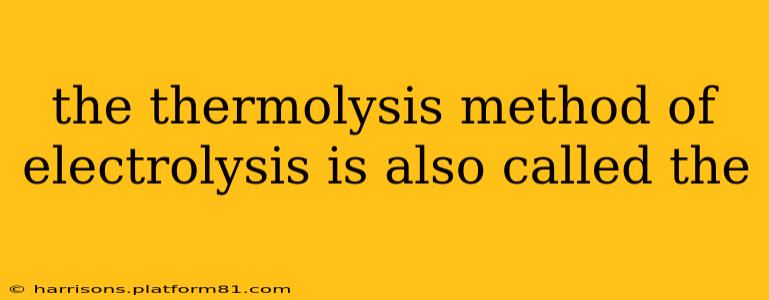The Thermolysis Method of Electrolysis: Also Known As...
Electrolysis, a permanent hair removal method, utilizes different modalities to achieve hair destruction. One such method is thermolysis, often referred to by another name due to its mechanism of action. This article explores what thermolysis is, how it works, and clarifies its other common name.
What is Thermolysis?
Thermolysis is a type of electrolysis that uses shortwave radio frequency energy to heat and destroy the hair follicle. A fine probe is inserted into the follicle, and a high-frequency current generates heat that coagulates the hair growth cells. This heat effectively damages the papilla, the structure responsible for hair growth, leading to permanent hair removal. The process is targeted and precise, working on individual hairs.
How Does Thermolysis Work?
The shortwave radio frequency current used in thermolysis creates heat within the hair follicle. This heat is precisely controlled to avoid damaging the surrounding skin. The heat energy causes coagulation necrosis, essentially "cooking" the cells within the hair follicle and preventing future hair growth. The process is relatively quick for individual hair treatments.
What is Thermolysis Also Called?
Thermolysis is also known as shortwave electrolysis or diathermy. These terms emphasize the use of shortwave radio frequencies and the heat-generating nature of the process, respectively. While "thermolysis" is often preferred by practitioners and in professional contexts, the other names are still commonly used and understood within the electrolysis field.
What are the Advantages of Thermolysis?
- Speed: Thermolysis can be faster than other electrolysis methods, particularly for treating larger areas.
- Precision: The targeted application of heat allows for precise treatment of individual hair follicles.
- Suitable for various hair types and skin tones: Thermolysis is often considered effective for various hair and skin types.
What are the Disadvantages of Thermolysis?
- Potential for discomfort: While modern devices minimize discomfort, some individuals may experience a slight stinging sensation during the procedure.
- Skill of the practitioner is crucial: The success of thermolysis depends significantly on the practitioner’s skill and experience in accurately applying the energy to the hair follicle.
Is Thermolysis Safe?
When performed by a qualified and experienced electrologist, thermolysis is generally considered a safe method of permanent hair removal. Choosing a licensed and reputable electrologist is critical to minimizing risks and maximizing results.
What is the Difference Between Thermolysis and Galvanic Electrolysis?
While both are forms of electrolysis, they differ in their mechanism of hair destruction. Galvanic electrolysis uses direct current to create a chemical reaction that destroys the hair follicle. Thermolysis, as discussed, uses radio frequency energy to generate heat for destruction.
How Long Does Thermolysis Take?
The time required for thermolysis treatment depends on several factors, including the size of the area being treated, the density of hair, and the individual's hair growth pattern. Small areas may take a shorter time, while larger areas can require multiple sessions.
This comprehensive overview clarifies that thermolysis is also commonly called shortwave electrolysis or diathermy, offering a clearer understanding of this permanent hair removal method. Remember to always consult a qualified and experienced electrologist for safe and effective treatment.
